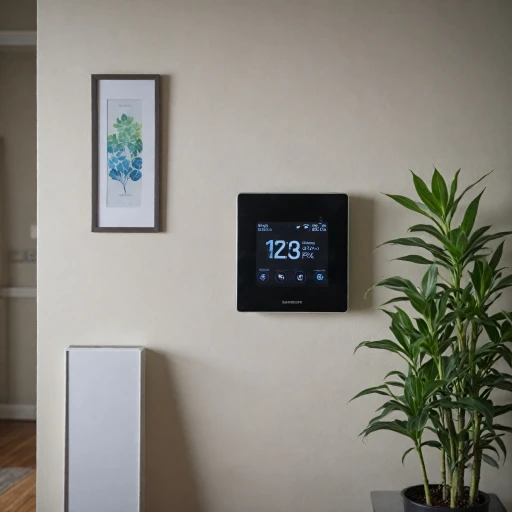Understanding Baseboard Heaters and Their Unique Requirements
Understanding Your Baseboard Heating System
Baseboard heaters, particularly electric baseboard heaters, provide a unique approach to warming a home. Unlike forced air systems, these heaters work silently along the perimeter of a room, ensuring even heat distribution by warming the air directly around them. This method necessitates specific considerations when it comes to thermostats.
When evaluating thermostat options, it is crucial to understand that baseboard heaters typically require high voltage thermostats. Traditional low voltage or programmable thermostats may not be compatible due to differing voltage requirements. Baseboard heating systems can either be double pole or single pole, with the choice affecting both installation processes and safety.
For those curious about enhancing comfort even further, understanding baseboard heaters and their demands aligns with broader home improvement techniques. For instance, utilizing Lutron's wireless ceiling fan light dimmer can complement your baseboard heater by circulating warm air and maintaining consistent comfort understanding your home's unique needs is essential.
Baseboard heaters, installed along the walls, generate heat that rises naturally. This type of heating doesn't integrate easily with central thermostat systems, thereby paving the way for solutions like smart thermostats that can be programmed to adapt independently to specific heat settings.
Smart Thermostats: Features and Benefits
The Smart Thermostat Advantage
Smart thermostats offer a unique set of features and benefits that can significantly enhance the control and efficiency of your heating system, especially for electric baseboard heaters. These smart devices allow you to control your heater from anywhere using your smartphone or voice-activated systems, such as smart speakers. This remote capability is particularly useful for managing energy consumption and ensuring comfort when you're away from home.Why You Should Consider a Smart Thermostat
- Energy Efficiency: Smart thermostats are programmed to learn your habits and adjust heating schedules automatically, thereby optimizing energy usage and providing cost savings on your power bill.
- Programmable Flexibility: With options like programmable thermostats, users can set precise schedules that align with their daily routines, enhancing both comfort and efficiency.
- User-Friendly Interfaces: Many models offer intuitive touchscreen displays or app interfaces, making them accessible for tech-savvy users and beginners alike.
- Integration with Other Smart Devices: Some smart thermostats can integrate with other devices, allowing for a holistic smart home experience. For example, syncing with smart lights or smart ceiling fans can further enhance home comfort.
Enhanced Control for Baseboard Heaters
Whether you are heating a single room or managing multiple zones in your home, smart thermostats provide granular control over each baseboard heater. Models like the Mysa Smart Thermostat are specifically designed for high voltage electric heating systems, delivering precise control in heating cooling scenarios. The Honeywell smart thermostat also provides robust performance for managing various heating options, including programmable settings for customized comfort.A Cost-Effective Investment
While the initial investment might seem substantial, the energy savings over time justify the cost. By using a smart thermostat, you can easily monitor energy consumption and make informed decisions to reduce your heating bills. Additionally, with features like adaptive heating and learning algorithms, these devices minimize wastage and enhance the environmental footprint of your home. For more insights on optimizing energy use in non-traditional settings, you can explore these strategies for greenhouses, which highlight the flexibility and innovation brought by smart thermostats. Overall, the features and benefits of smart thermostats make them an excellent choice for those looking to optimize their heating systems for both comfort and efficiency. Whether you are considering a Mysa, Honeywell, or another brand, these devices can transform the way you experience warmth at home.Compatibility Considerations for Baseboard Heaters
Considering Compatibility with Existing Systems
When selecting a smart thermostat for your baseboard heater, ensuring compatibility with your existing heating system is crucial. Baseboard heaters have unique requirements that differ from forced-air systems, necessitating a precise match to function efficiently.
Compatibility involves understanding the type of thermostat your heater requires. Baseboard heaters typically operate on either single pole or double pole circuits, which affects the type of thermostat you need. Here are some key considerations:
- Voltage Type: Check if your heater is a low voltage or line voltage system. Most electric baseboard heaters require voltage thermostats designed for 120V or 240V circuits. Choosing a thermostat electric model that matches your system's voltage is paramount to avoid malfunction and potential hazards.
- Type of Control: Decide whether you need a programmable thermostat or a non-programmable one. Smart thermostats can provide programmable features, enabling better control over heating schedules, enhancing the energy efficiency of your home.
- Wiring Needs: Consider the wiring layout of your existing system. Smart thermostats differ in wire requirements, so ensuring compatibility with cut-in boxes and wiring setups is vital.
Evaluating these elements will help you determine whether your current heating system can accommodate one of the many modern smart thermostats available on the market, such as those by Honeywell or Mysa smart models. Ensuring that your chosen heater thermostat matches these criteria can lead to better energy savings and enhanced comfort.
For more insights into upgrading your home's heating solutions, explore the benefits of adding a well-matched smart thermostat and ensure seamless integration with your system.
Energy Efficiency and Cost Savings
Boosting Efficiency and Reducing Bills
When it comes to reducing energy consumption and saving on your heating bills, smart thermostats provide significant advantages over traditional models. A key feature of a smart thermostat is its ability to optimize your heating schedule according to your lifestyle, which is especially beneficial when managing electric baseboard heaters. By adopting a programmable thermostat for your home, you can enhance comfort while also being mindful of your budget. Smart thermostats provide advanced technology that automatically adjusts the temperature in your home, improving the efficiency of your electric heating system. By choosing efficient thermostats programmable with this capability, you can achieve the perfect balance of warmth and cost-saving benefits during cold months. Additionally, smart thermostats offer the following advantages for baseboard heaters:- Learning Algorithms: Many models, like the Mysa smart thermostat, learn your schedule and preferences, adjusting the temperature accordingly to ensure energy isn’t wasted when you're not home.
- Remote Access: With Wi-Fi-enabled smart thermostats, you can control the temperature from your smartphone, allowing you to manage and adjust heating even when you’re away.
- Detailed Energy Reports: Some smart thermostats provide reports on your energy usage, helping you understand where you can make changes to further improve efficiency and savings.
Installation and Setup Tips
Setting Up Your Smart Thermostat with Precision
When it comes to enhancing the efficiency and functionality of electric baseboard heaters, installing a smart thermostat requires careful attention. Here’s a guide to ensuring a smooth setup process:- Understand Wiring Requirements: Start by identifying whether your setup uses single pole or double pole thermostats. This distinction is crucial as it affects the connectivity and safety of your heater thermostat adjustments. Double pole thermostats typically offer more flexibility for electric heating.
- Check Voltage Compatibility: Electric baseboard heaters typically operate at higher voltages. Ensure your smart thermostat is compatible with these voltage levels. Low voltage thermostats may not be suitable for electric heating systems like baseboards, so consult your heater’s specifications.
- DIY Installation vs. Professional Help: Some smart thermostats, such as the Mysa Smart, offer user-friendly installation guides with their programmable thermostat models. These resources can assist with the installation process. However, if you're inexperienced with electrical work, hiring a professional can be a smart choice to ensure your baseboard heaters are safely wired.
- Programming for Efficiency: Once installed, configure your smart thermostat with programmable settings to optimize energy consumption. Adjusting heating and cooling schedules can significantly reduce energy usage and costs. Many smart thermostats feature intuitive apps for effortless programming.
- Linking with Smart Home Devices: Enhance your thermostat’s functionality by integrating it with other smart home systems. Compatible devices can streamline your heating experience and add layers of convenience with voice control and remote access through apps.
Top Smart Thermostat Recommendations for Baseboard Heaters
Top Picks for Smart Thermostats Suitable for Baseboard Heaters
When it comes to selecting the ideal smart thermostat for your electric baseboard heaters, it’s crucial to consider compatibility and functionality. Here are some top recommendations that align well with the unique requirements of baseboard heating systems:
- Mysa Smart Thermostat: This thermostat is specifically designed for high voltage electric baseboard heaters. It offers Wi-Fi connectivity, allowing you to control your heating from anywhere using a smartphone app. Mysa is known for its sleek design and energy-saving features, making it a popular choice for modern homes.
- Honeywell Home RLV4305A: A programmable thermostat that supports electric heating systems. It provides precise temperature control and can be programmed to fit your daily schedule, enhancing both comfort and energy efficiency.
- Stelpro Maestro Smart Thermostat: This thermostat integrates with smart home systems and provides advanced energy management features. It’s designed for electric baseboard heaters and offers both single pole and double pole options, catering to different wiring requirements.
These smart thermostats not only offer convenience and control but also contribute to energy savings by optimizing your heating schedule. When choosing a thermostat, ensure it matches the voltage and wiring specifications of your baseboard heaters. Remember, the right thermostat can significantly enhance your home’s comfort and efficiency.





